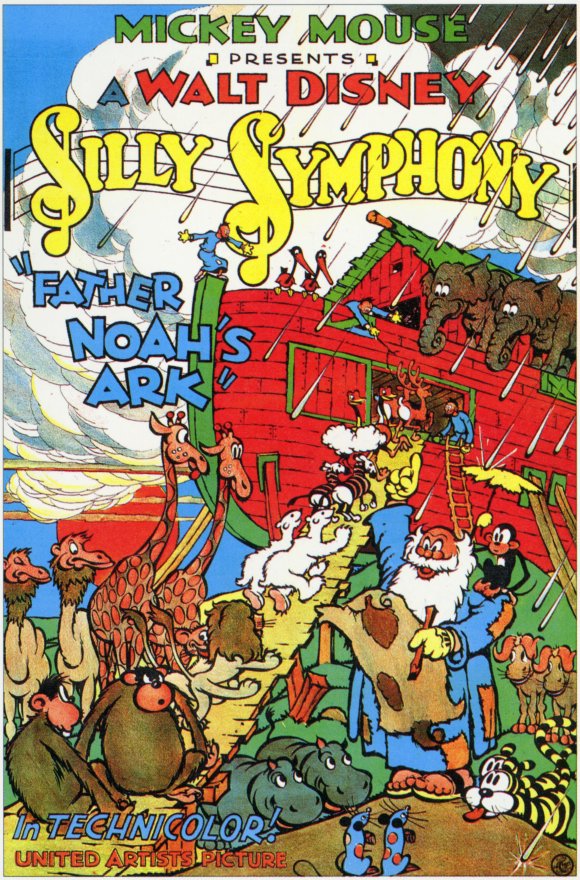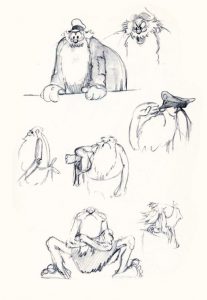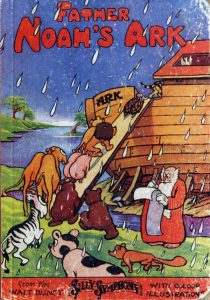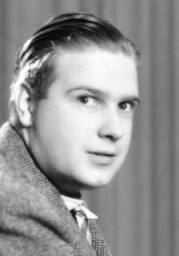
Forecast calls for 40 days and 40 nights of rain, so climb aboard Noah’s ark for this week’s animator breakdown!
 In November 1932, the Disney studio produced a story outline based around the biblical tale of Noah’s ark, from the book of Genesis. For the core development in this cartoon, the story artists approached this film differently than their accustomed methods. Instead of a large group passing around each story sketch to each other in their conference room, the drawings were pinned on a corkboard to convey the narrative. However, this was only the preliminary form of a storyboard—as director Wilfred Jackson recalled, the sketches only illustrated a certain gag, or a short continuity for sequential action, rather than follow its narrative path from beginning to end.
In November 1932, the Disney studio produced a story outline based around the biblical tale of Noah’s ark, from the book of Genesis. For the core development in this cartoon, the story artists approached this film differently than their accustomed methods. Instead of a large group passing around each story sketch to each other in their conference room, the drawings were pinned on a corkboard to convey the narrative. However, this was only the preliminary form of a storyboard—as director Wilfred Jackson recalled, the sketches only illustrated a certain gag, or a short continuity for sequential action, rather than follow its narrative path from beginning to end.
During this period, Disney hired Don Graham, an instructor from Choiunard Institute, to teach life drawing classes to his animators two nights a week. With Graham’s background in engineering, he gave the artists a more advanced, volumetric approach to drawing. By January 1933, when animation on the film began, their skills improved significantly, but showed weaknesses in other aspects. In the animation of the menagerie of animals in Father Noah’s Ark, there is a sense of observation in their movements, compared to the human characters, like Noah and his wife, who are drawn more “cartoony.” In the case of Noah’s sons, there is an apparent lack of care in facial proportions. Both cases were inevitable: the studio hardly featured human characters in their cartoons.
 Since Father Noah’s Ark relies on a profusion of movement with many characters onscreen, the chief animators of the studio—which included Norm Ferguson, Dick Lundy, and Gerry Geronimi—are only given brief key sequences. The junior Disney animators, supervised by Ben Sharpsteen, dominate much of the film’s action. Ham Luske transitioned into a full-fledged animator during the production of this cartoon. His animation of the human characters is significantly sharper than Ferguson and Lundy’s scenes. Besides animating the sequence of Noah and his sons trumpeting a call for the animals to assemble to the ark (scene 15), Luske also handles Noah and the family singing after their voyage, and a dove bestowing an olive branch to Noah.
Since Father Noah’s Ark relies on a profusion of movement with many characters onscreen, the chief animators of the studio—which included Norm Ferguson, Dick Lundy, and Gerry Geronimi—are only given brief key sequences. The junior Disney animators, supervised by Ben Sharpsteen, dominate much of the film’s action. Ham Luske transitioned into a full-fledged animator during the production of this cartoon. His animation of the human characters is significantly sharper than Ferguson and Lundy’s scenes. Besides animating the sequence of Noah and his sons trumpeting a call for the animals to assemble to the ark (scene 15), Luske also handles Noah and the family singing after their voyage, and a dove bestowing an olive branch to Noah.
Tom Bonfiglio (also known as Tom Goodson) served as one of the junior animators, only credited with scene 10, when a rhinoceros is used to split lumber into planks with his horn. Mark Kausler remembered Bonfiglio—his first animation boss in St. Louis—stating he was credited with more scenes of the animals, with a host of animators, particularly scenes 16 through 21. As Bonfiglio further explained, the greener animators labored on many of their scenes without any overtime pay. In a sense, the assembly-line methods shown in the cartoon, with the animals collectively constructing the ark, allude to the inexperienced artists who toiled on these small but demanding scenes for Disney’s product. Such working conditions might explain why a few artists, like Bonfiglio, stayed with Disney for only a short period.

Leigh Harline
In one of two production drafts of Father Noah’s Ark, Ferdinand Horvath was originally intended to animate sc. 16—a “mob scene” of animals hearing the assembly call and rushing to the ark, a few weeks after he was hired at the studio on January 1933. Horvath’s letters to his wife Elly, dated early February (translated and documented by historian Didier Ghez) indicate that he faced difficulty and tedium with the sequence, after his time away from his previous experience animating at Paul Terry’s studio in the Bronx. The scene was re-assigned to Chuck Couch by late February.
Another major new Disney hire, during the production of Father Noah’s Ark, was musical composer Leigh Harline. Harline majored in music at the University of Utah and became prominent on radio—as a composer, conductor and harmonist, among other duties—in the late 1920s and early 1930s before Disney recruited him in 1932. The first section of the cartoon’s score, as Noah’s household and animals build the ark, is based around the first dance of Ludwig van Beethoven’s 12 Contradanses. Harline also composed original compositions for the film, namely the spiritual sung by Noah and his family as the ark is tossed against the floodwaters and “The Skies are Clear,” when the boundless rainstorm ceases.
Production on Father Noah finished by late March 1933, and the film was released on April 8th. Two 1933 production drafts are shown below the breakdown video: one typewritten and the other hand-written. In this case, Sharpsteen’s crew of junior animators is credited on both drafts, whereas some other production papers are left blank, with only their supervisor credited. As indicated on both drafts, two sequences during the final sequences of Noah’s ark on land were animated, but left out of the finished film—scene 41 of Mother Noah sighting land (credited to Nick George) and in scenes 43 and 44, as the family sing and dance on the ark (credited to Marvin Woodward), before the long shots of the animals disembarking.


Enjoy! Next up is that “tall, dark and gruesome” Daffy Duck…
(Thanks to Mark Kausler, J.B. Kaufman, Michael Barrier and Didier Ghez for their help.)


 DEVON BAXTER is a film restoration artist, video editor, and animation researcher/writer currently residing in Pennsylvania. He also hosts a
DEVON BAXTER is a film restoration artist, video editor, and animation researcher/writer currently residing in Pennsylvania. He also hosts a 




















































































Keep these going, Devon! These are great!
Nice that you brought this up, because this is one the first Disney cartoons I’ve remembered watching.
I remember Van Beuren’s take on the biblical tale: “Noah Knew His Ark,” which ended with Noah and the animals singing “It Ain’t Gonna Rain No More.”
Lots of familiar yet surprising names in this breakdown, such as MGM and HB animator Ed Love, Little Toot author Hardie Gramatky and Roy Williams from the original Mickey Mouse Club.